ALDH4A1 Mouse Monoclonal Antibody [7E2]

cat.: EM1701-74
| Product Type: | Mouse monoclonal IgG1, primary antibodies |
|---|---|
| Species reactivity: | Human, Mouse, Rat |
| Applications: | WB, IHC-P, IF-Cell, IF-Tissue |
| Clonality: | Monoclonal |
| Clone number: | 7E2 |
| Form: | Liquid |
| Storage condition: | Store at +4℃ after thawing. Aliquot store at -20℃. Avoid repeated freeze / thaw cycles. |
| Storage buffer: | 1*PBS (pH7.4), 0.2% BSA, 50% Glycerol. Preservative: 0.05% Sodium Azide. |
| Concentration: | 2ug/ul |
| Purification: | Protein G affinity purified. |
| Molecular weight: | Predicted band size: 62 kDa |
| Isotype: | IgG1 |
| Immunogen: | Synthetic peptide within Human ALDH4A1 aa 514-563 / 563. |
| Positive control: | HepG2 cell lysate, SK-Br-3 cell lysate, human kidney tissue lysate, human liver tissue lysate, mouse liver tissue lysate, rat liver tissue lysate, HepG2, human kidney tissue, human liver tissue, mouse liver tissue, rat liver tissue. |
| Subcellular location: | Mitochondrion matrix. |
| Recommended Dilutions:
WB IHC-P IF-Cell IF-Tissue |
1:1,000-1:5,000 1:1,000 1:100 1:100 |
| Uniprot #: | SwissProt: P30038 Human | Q8CHT0 Mouse | P0C2X9 Rat |
| Alternative names: | AL4A1_HUMAN aldehyde dehydrogenase 4 aldehyde dehydrogenase 4 family, member A1 Aldehyde dehydrogenase family 4 member A1 Aldehyde dehydrogenase, family 4, subfamily A, member 1 ALDH4 aldh4a1 Delta 1 pyrroline 5 carboxylate dehydrogenase, mitochondrial Delta-1-pyrroline-5-carboxylate dehydrogenase L-glutamate gamma-semialdehyde dehydrogenase mitochondrial mitochondrial delta-1-pyrroline 5-carboxylate dehydrogenase P5C dehydrogenase P5CD P5CDh P5CDhL P5CDhS Pyrroline-5-carboxylate dehydrogenase RP11 128M10.1 |
Images
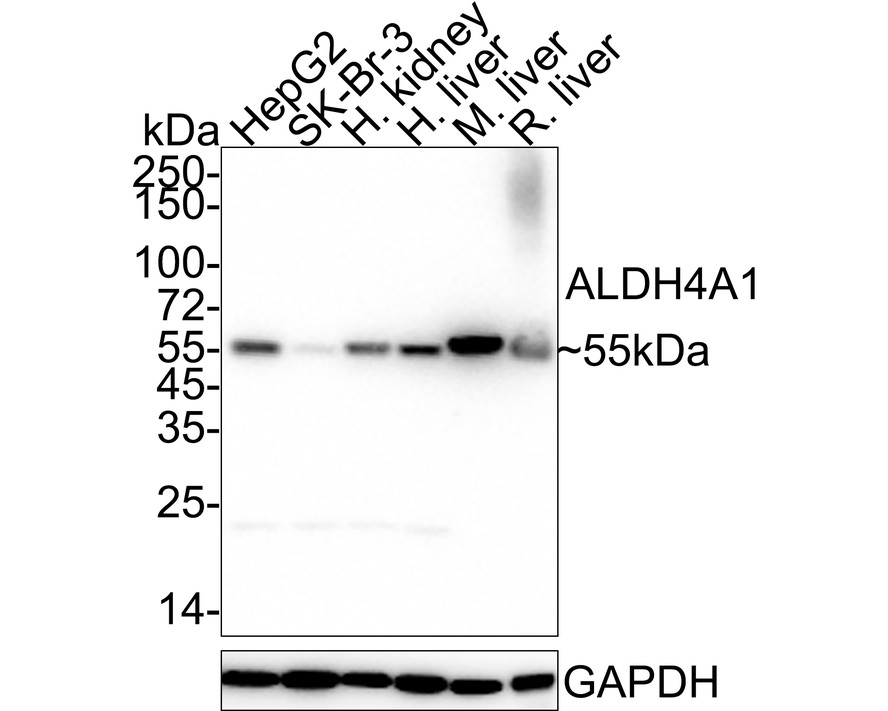
|
Fig1:
Western blot analysis of ALDH4A1 on different lysates with Mouse anti-ALDH4A1 antibody (EM1701-74) at 1/5,000 dilution. Lane 1: HepG2 cell lysate (20 µg/Lane) Lane 2: SK-Br-3 cell lysate (20 µg/Lane) Lane 3: Human kidney tissue lysate (40 µg/Lane) Lane 4: Human liver tissue lysate (40 µg/Lane) Lane 5: Mouse liver tissue lysate (40 µg/Lane) Lane 6: Rat liver tissue lysate (40 µg/Lane) Predicted band size: 62 kDa Observed band size: 55 kDa Exposure time: 30 seconds; 4-20% SDS-PAGE gel. Proteins were transferred to a PVDF membrane and blocked with 5% NFDM/TBST for 1 hour at room temperature. The primary antibody (EM1701-74) at 1/5,000 dilution was used in 5% NFDM/TBST at 4℃ overnight. Goat Anti-Mouse IgG - HRP Secondary Antibody (HA1006) at 1/50,000 dilution was used for 1 hour at room temperature. |
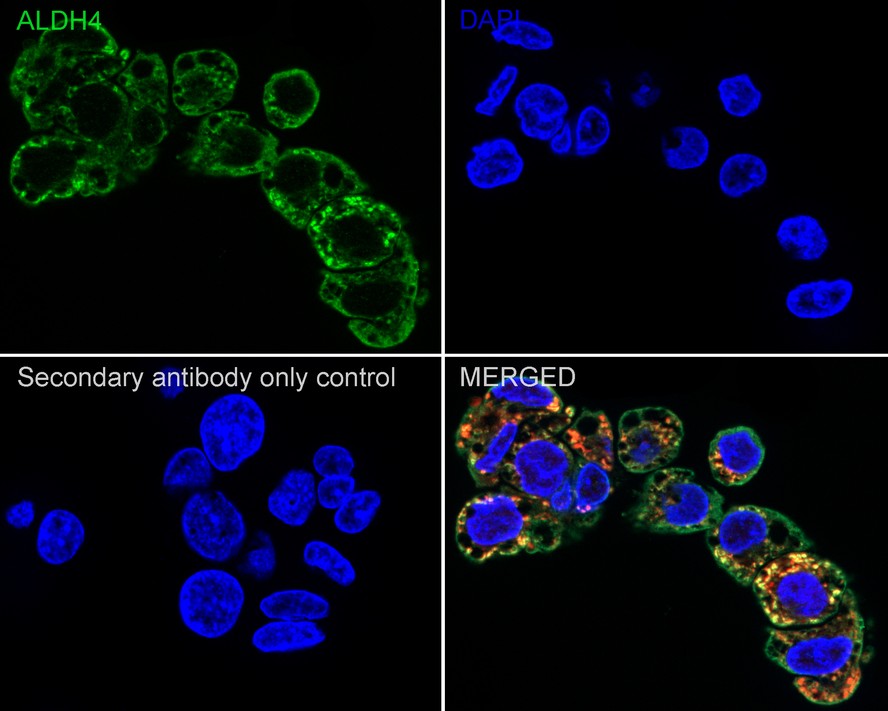
|
Fig2:
Immunocytochemistry analysis of HepG2 cells labeling ALDH4A1 with Mouse anti-ALDH4A1 antibody (EM1701-74) at 1/100 dilution. Cells were fixed in 4% paraformaldehyde for 20 minutes at room temperature, permeabilized with 0.1% Triton X-100 in PBS for 5 minutes at room temperature, then blocked with 1% BSA in 10% negative goat serum for 1 hour at room temperature. Cells were then incubated with Mouse anti-ALDH4A1 antibody (EM1701-74) at 1/100 dilution in 1% BSA in PBST overnight at 4 ℃. Goat Anti-Mouse IgG H&L (iFluor™ 488, HA1125) was used as the secondary antibody at 1/1,000 dilution. PBS instead of the primary antibody was used as the secondary antibody only control. Nuclear DNA was labelled in blue with DAPI. beta Tubulin (ET1602-4, red) was stained at 1/100 dilution overnight at +4℃. Goat Anti-Rabbit IgG H&L (iFluor™ 594, HA1122) were used as the secondary antibody at 1/1,000 dilution. |
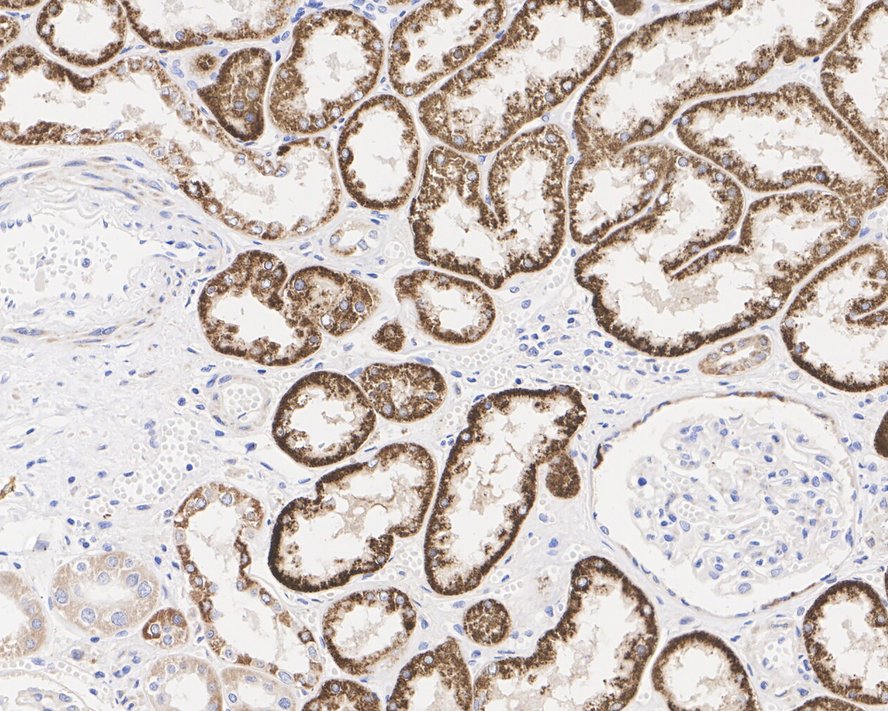
|
Fig3:
Immunohistochemical analysis of paraffin-embedded human kidney tissue with Mouse anti-ALDH4A1 antibody (EM1701-74) at 1/1,000 dilution. The section was pre-treated using heat mediated antigen retrieval with Tris-EDTA buffer (pH 9.0) for 20 minutes. The tissues were blocked in 1% BSA for 20 minutes at room temperature, washed with ddH2O and PBS, and then probed with the primary antibody (EM1701-74) at 1/1,000 dilution for 1 hour at room temperature. The detection was performed using an HRP conjugated compact polymer system. DAB was used as the chromogen. Tissues were counterstained with hematoxylin and mounted with DPX. |
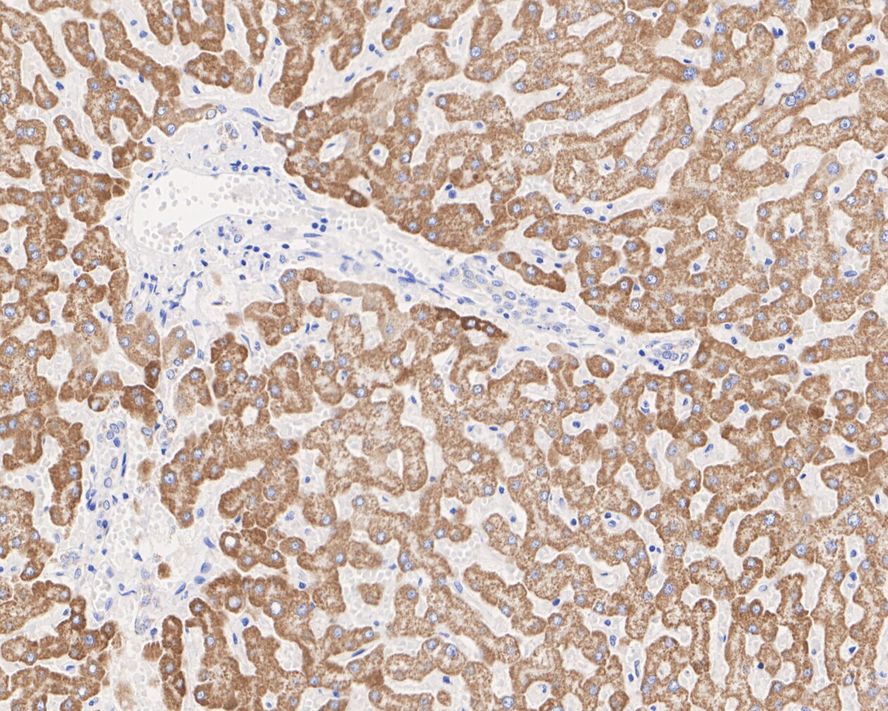
|
Fig4:
Immunohistochemical analysis of paraffin-embedded human liver tissue with Mouse anti-ALDH4A1 antibody (EM1701-74) at 1/1,000 dilution. The section was pre-treated using heat mediated antigen retrieval with Tris-EDTA buffer (pH 9.0) for 20 minutes. The tissues were blocked in 1% BSA for 20 minutes at room temperature, washed with ddH2O and PBS, and then probed with the primary antibody (EM1701-74) at 1/1,000 dilution for 1 hour at room temperature. The detection was performed using an HRP conjugated compact polymer system. DAB was used as the chromogen. Tissues were counterstained with hematoxylin and mounted with DPX. |
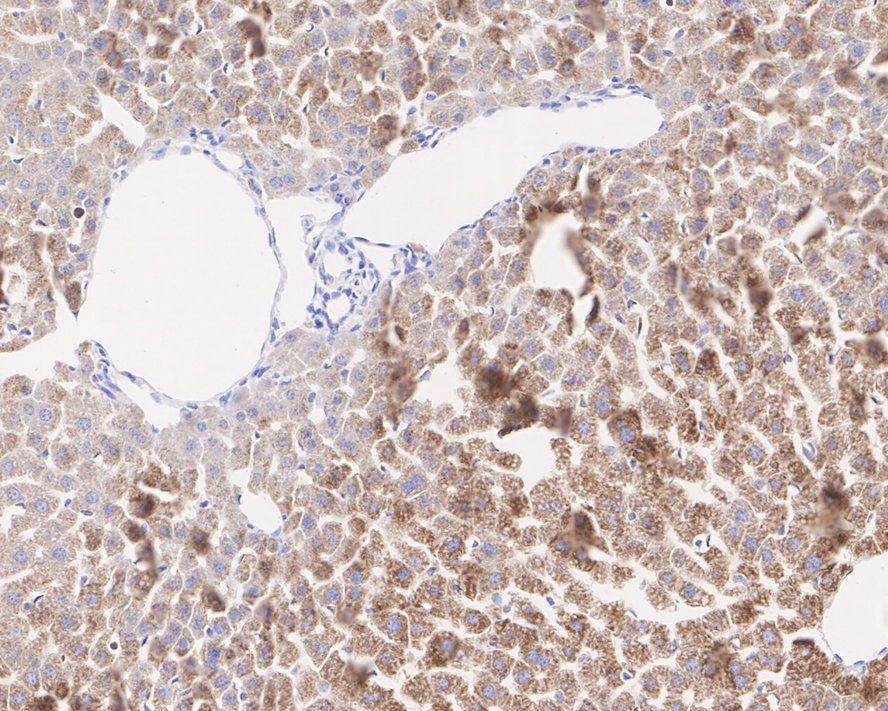
|
Fig5:
Immunohistochemical analysis of paraffin-embedded mouse liver tissue with Mouse anti-ALDH4A1 antibody (EM1701-74) at 1/1,000 dilution. The section was pre-treated using heat mediated antigen retrieval with Tris-EDTA buffer (pH 9.0) for 20 minutes. The tissues were blocked in 1% BSA for 20 minutes at room temperature, washed with ddH2O and PBS, and then probed with the primary antibody (EM1701-74) at 1/1,000 dilution for 1 hour at room temperature. The detection was performed using an HRP conjugated compact polymer system. DAB was used as the chromogen. Tissues were counterstained with hematoxylin and mounted with DPX. |
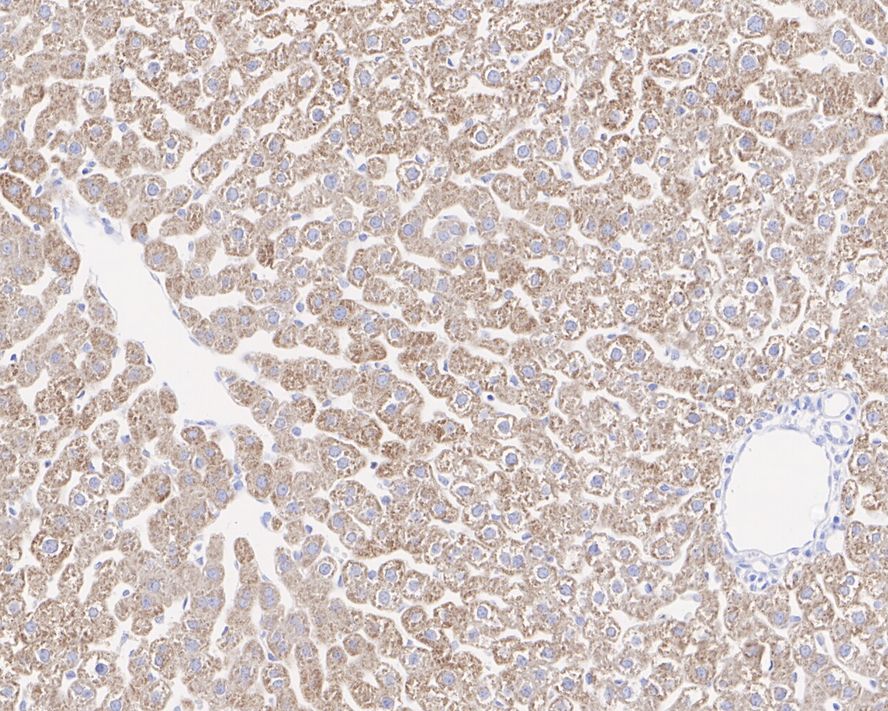
|
Fig6:
Immunohistochemical analysis of paraffin-embedded rat liver tissue with Mouse anti-ALDH4A1 antibody (EM1701-74) at 1/1,000 dilution. The section was pre-treated using heat mediated antigen retrieval with Tris-EDTA buffer (pH 9.0) for 20 minutes. The tissues were blocked in 1% BSA for 20 minutes at room temperature, washed with ddH2O and PBS, and then probed with the primary antibody (EM1701-74) at 1/1,000 dilution for 1 hour at room temperature. The detection was performed using an HRP conjugated compact polymer system. DAB was used as the chromogen. Tissues were counterstained with hematoxylin and mounted with DPX. |

|
Fig7:
Immunofluorescence analysis of paraffin-embedded mouse liver tissue labeling ALDH4A1 with Mouse anti-ALDH4A1 antibody (EM1701-74) at 1/100 dilution. The section was pre-treated using heat mediated antigen retrieval with Tris-EDTA buffer (pH 9.0) for 20 minutes. The tissues were blocked in 10% negative goat serum for 1 hour at room temperature, washed with PBS, and then probed with the primary antibody (EM1701-74, green) at 1/100 dilution overnight at 4 ℃, washed with PBS. Goat Anti-Mouse IgG H&L (iFluor™ 488, HA1125) was used as the secondary antibody at 1/1,000 dilution. Nuclei were counterstained with DAPI (blue). |
Note: All products are “FOR RESEARCH USE ONLY AND ARE NOT INTENDED FOR DIAGNOSTIC OR THERAPEUTIC USE”.